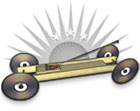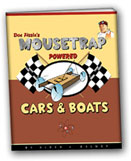Mousetrap Cars: Weight Distribution
Learn all about weight distribution and how the number of wheels effects a mousetrap racer. You cannot build a winning mousetrap racer until you know the basics.
Not just with mousetrap cars but with all machines the more wheels and/or pulleys the machine has the more rotational inertia of the system. But sometimes things are not as easy as they first appear, in some cases using fewer wheels on a mousetrap vehicle can actually increase the force of friction on the system. Here is the explanation, with a four-wheeled vehicle that has four bearing points the weight of the vehicles chassis is supported by each of the four bearing points. The force of friction at any one of the bearing point depends on the total weight supported by the bearing; the more weight supported at the bearing point the greater the force of friction at that same bearing point. On two identical mousetrap cars, if we remove one of the wheels and remove one of the bearing points (a three-wheeled vehicle) we will then decrease the rotational inertia of the system but increase the force of friction since the weight of the chassis is now only supported by three bearing points.

bonus tip: a vehicle with only three bearing points will have more friction than an identical car with four bearing points.
Each wheel increases the rotational inertia of the system. In most cases a mousetrap vehicle with fewer wheels will have less rotational inertia compared to a similar mousetrap car with more wheels. Depending on the rules for the contest try to design a vehicle that uses three wheels verses the same design that uses four wheels. If you are building a big-wheeled long distance racer try to use only one big wheel on the drive axle instead of two big wheels that would double the rotational inertia of the axle set-up. This same concept can be applied to speed-trap racers, try using only one drive wheel in order to cut down on the rotational inertia.

bonus tip: Each of these vehicles uses only one drive wheel in order to cut down on the number of wheels and the rotational inertia of the system.
Three or Four Wheels?
So what is better, three wheels or four wheels? The answer depends on the contest, if we are to build a super fast accelerating speed-trap racer then over coming rotational inertia is one of the main objectives therefor three wheels will always do better than four wheels when it comes to performance. If we are building a slow moving long distance traveler then rotational inertia is not as big a deal as decreasing friction. The answer for a distance racer still depends on the number of bearing points and not the number of wheels. If we compare two identical mousetrap cars, one with four wheels and one with three wheels and both have the same number of bearing points then the mousetrap car with three wheels will go further than the one with four wheels. But if one of our mousetrap cars has three bearing points and the other four bearing points then the vehicle with four bearing points will do better since it has less total friction. As in all situations, sometimes you just have to test your mousetrap vehicle with three wheels and then with four wheels to see if there is an performance difference.

bonus tip: the number of wheels depends on the contest and the number of bearing points. Speed-trap racers with fewer wheels have greater acceleration.

bonus tip: bearing points are more important with long-distance racers. Four bearing points have less friction than three bearing points.
*Can't find what you're looking for? Ask Doc Fizzix »




